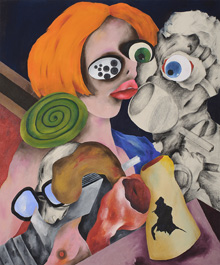
‘Untitled,’ 2011, 36 by 30 inches |
Maine has recently been making big strides as a forum for contemporary art of international significance. Closely following the opening of the Alfond-Lunder Family Pavilion at the Colby College Museum of Art, which includes first-rate contemporary pieces (see “The Wonder of Lunder,” by Ken Greenleaf, August 9), the Portland Museum of Art now showcases one of the newest stars of the international art world, Ahmed Alsoudani. Co-organized with the Phoenix Art Museum, “Ahmed Alsoudani: Redacted” comprises 20 paintings executed since 2010.
Alsoudani’s critical reception could easily be fodder for institutional criticism of the kind Andrea Fraser has championed, pointing out the divisions of labor within the art world that are geared toward legitimation and production of belief in value. No matter how skeptical one is of endorsements by high-stakes players, this show is a big deal for Portland — not least because the artist went to the Maine College of Art. Alsoudani is just 38 years old and has already represented his native Iraq at the Venice Biennale (2011), participated in group shows in Italy, England, France, Germany, Canada, and Korea, is being collected by Charles Saatchi and Francois Pinault, and is represented by Haunch of Venison.
Looking at Alsoudani’s work from the interrelated angles of the purely aesthetic, content-driven, and biographical proves immensely appropriate. In much writing on him, the personal turns into a narrative of heroic and redeeming proportions, overshadowing or even supplanting discussion of artistic merit, so let’s get the biography out of the way. Born in Baghdad in 1975, Alsoudani fled Iraq for fear of repercussions following a youthful defacement of a Hussein mural (talk about anticipatory history painting!). After a stay in Damascus, he was eventually granted asylum (and later citizenship) in the United States. In 2005 he received his BFA at the Maine College of Art and then went for his MFA at the Yale School of Art. Alsoudani now lives in New York and has over the years received personal encouragement from influential people like Robert Storr.
The mostly large paintings at the PMA read from afar as colorful, even joyful abstractions and look stunning in the high-ceilinged gallery. They need the extra space around them, because when beginning to decipher the imagery intense, almost claustrophobic reactions set in. To verbally describe Alsoudani’s paintings is difficult and seems counterintuitive. They aim for your gut, and that is how we understand them. The canvases writhe with abstract and figurative forms crowding each other, all rendered in charcoal and candy-colored acrylic paint.
The most recent painting, “Untitled” (2013, 80 by 50 inches; all works on view are untitled), differs from the rest through its compositional uniformity. Fleshy pink and grey worm-like forms, some with sutured wounds, combine into a squiggling whirlpool of remnants of life. Two eyeballs, a recurring motif that acts as witness and direct interaction with the viewer, peer out of the mess, clarifying that humans after all are the subject of Alsoudani’s work.